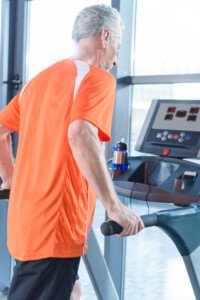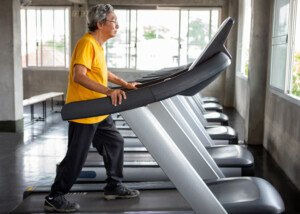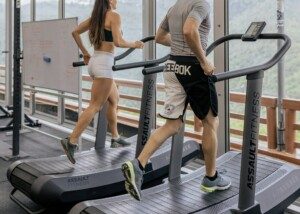
If you’re over 55 and walk on a treadmill, do you normally hold on?
The man pictured here, walking on a treadmill, appears to be between 55 and 65, and he’s doing it wrong.
There is the smart way to use a treadmill for those 55+: Do not hold onto the rails or the front.
The man in the photo appears to be posing for the photographer. For all we know, the tread motor isn’t even running.
Or maybe he told the model, “Just turn on the machine and start walking and I’ll take some shots.”
Either way, one thing is for sure: The way this man is positioned is highly representative of what the vast majority of people age 55-plus do when they walk on a treadmill.
So whether he’s posing still or walking for real, he’s demonstrating what I’ve seen for years as a personal trainer at gyms all over:
People holding onto the treadmill while walking. This is wrong. Even if you’re past 55.
Look at his posture. Does it look correct to you? Does his gait look smart? His back, his “core” and lumbar area, are clearly being supported by his arms as his hands hold onto the rails.
This has absolutely NO transference to real-life walking, where there’s nothing to hold onto for support.
For example, suppose this man plays golf.
There’s a lot of walking on a golf course, including inclined terrain.
How will holding onto a treadmill, leaning on the hands, slightly stooped over, carry over to all the walking that one does on a golf course?
Good posture is vital, and as people get older, it becomes increasingly crucial.
Holding onto a treadmill may at first seem like the smart thing for the person age 55-plus to do, but give this some thought and you’ll realize how detrimental this fake walking really is—even for people who’ve been sedentary all their lives.
One of the problems that can result involve the feet.
“Holding onto the side or front rails on the treadmill will actually alter the gait pattern, possibly changing the biomechanics of the foot, joints and motion, thereby increasing the likelihood of injury or problems that occur with repetitive stress,” explains Alan L. Bass, DPM, Medical Director, NEMO Capital Partners, LLC.
“Acute injuries such as ankle injuries, or even chronic ones such as the development of bunion problems from repetitive stress on the forefoot when altering the biomechanics.”
Again, take a good hard look at this man’s posture. Yes, he may be a professional model just posing, but his body position is precisely what goes on at every single health club and gym.
This is such an unnatural way to walk and will do you no good. Take your hands off the treadmill. Otherwise, holding on mimics using a walker.

 Dr. Bass is with Central Jersey Foot & Ankle Care, and is a Fellow of the American College of Foot and Ankle Orthopedics and Medicine.
Dr. Bass is with Central Jersey Foot & Ankle Care, and is a Fellow of the American College of Foot and Ankle Orthopedics and Medicine.







































